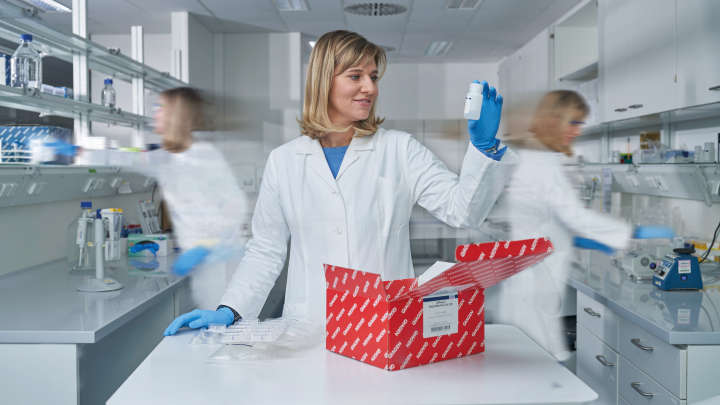✓ 연중무휴 하루 24시간 자동 온라인 주문 처리
✓ 풍부한 지식과 전문성을 갖춘 제품 및 기술 지원
✓ 신속하고 안정적인 (재)주문
QIAcuity Nanoplate 26k 8-well (10)
카탈로그 번호 / ID. 250031
✓ 연중무휴 하루 24시간 자동 온라인 주문 처리
✓ 풍부한 지식과 전문성을 갖춘 제품 및 기술 지원
✓ 신속하고 안정적인 (재)주문
특징
- 다양한 애플리케이션 요구 사항을 위한 네 개의 나노플레이트
- 웰당 최대 8,500개 또는 26,000개 분획
- SBS 형식
제품 세부 정보
QIAcuity Nanoplates는 웰당 최대 8,500개 또는 26,000개 분획으로 8개, 24개 또는 96개의 검체를 분석할 수 있는 미세 유체 디지털 PCR 플레이트입니다. 네 가지 나노플레이트 모두 QIAcuity 디지털 PCR 기기에서 실행하도록 설계되었습니다.
나노플레이트는 QIAcuity Digital PCR System에서만 사용할 수 있습니다. QIAgility를 사용하여 QIAcuity Nanoplate에서 자동 액체 취급 및 PCR 설정을 수행할 때는 QIAcuity Nanoplate 전용Adapter를 사용하십시오. 그런 다음, dPCR 반응을 위해 QIAcuity Digital PCR System에 플레이트를 로딩합니다.
제품에 대해 자세히 알아보고 당사의 dPCR 전문가에게 문의하시겠습니까? 여기에 정보를 기입하시면 곧 연락드리겠습니다.
성능
이 플레이트는 QIAcuity 기기의 디지털 PCR 반응에 사용하기 위해 특별히 설계된 플레이트입니다. QIAGEN은 네 가지 나노플레이트 유형을 제공하며 모두 염기서열분석(Sequencing by Synthesis, SBS) 형식이지만 다양한 애플리케이션 요구 사항에 따라 사양이 다릅니다.
| 유형 | 프레임 색상 | 사양 | 애플리케이션 |
| Nanoplate 26K 8-well | 연한 파란색 |
8-well x 대략 26,000개 분획 웰당 40µl dPCR 반응 |
희귀 돌연변이 검출, 액체 생검, 유전자 발현 분석, 병원체 검출 등. |
| Nanoplate 26K 24-well | 파란색 |
24-well x 대략 26,000개 분획 웰당 40µl dPCR 반응 |
희귀 돌연변이 검출, 액체 생검, 유전자 발현 분석, 병원체 검출 등 |
| Nanoplate 8.5K 24-well | 흰색 |
24-well x 대략 8500개 분획 웰당 12µl dPCR 반응 |
복제 수 변이 분석, 유전자 발현 분석, NGS 라이브러리 정량화, 유전체 편집 검출 등 |
| Nanoplate 8.5K 96-well | 회색 |
96-well x 대략 8500개 분획 웰당 12µl dPCR 반응 |
원리
피펫팅 및 로딩, 실험 실행, 결과 분석의 간단한 3단계로 2시간 이내에 원하는 dPCR 결과를 얻을 수 있습니다. 나노플레이트에서의 dPCR 반응 원리는 여기에 설명되어 있습니다.
절차
qPCR 실험과 마찬가지로 검체 준비에는 마스터 혼합물, 프로브 및 프라이머를 8웰, 24웰 또는 96웰 나노플레이트로 옮긴 다음 검체를 추가하는 작업이 포함됩니다. 이 시스템은 분획, 열순환 및 이미징을 하나의 완전 자동화 기기로 통합하여 사용자가 2시간 이내에 검체에서부터 결과를 얻을 수 있습니다. Suite 소프트웨어에서 분석을 수행할 수 있으며, 표적 서열의 마이크로리터당 복제 농도뿐만 아니라 양성 검체나 NTC와 같은 품질 관리도 제공됩니다. 이 분석은 또한 동일한 LAN(근거리 통신망) 내의 원격 컴퓨터로 확장될 수 있습니다.
응용 분야
QIAcuity Nanoplates는 QIAcuity Digital PCR System 및 QIAcuity PCR 키트와 함께 다음을 포함한 디지털 PCR 애플리케이션을 지원합니다.
- 희귀 돌연변이 검출
- 복제 수 변이 분석
- 유전자 발현 분석
- 병원체 검출
- 유전형 분석 (genotyping)
- miRNA 연구
- 세포 및 유전자 치료
- 잔류 DNA 정량화
- 폐수 모니터링

